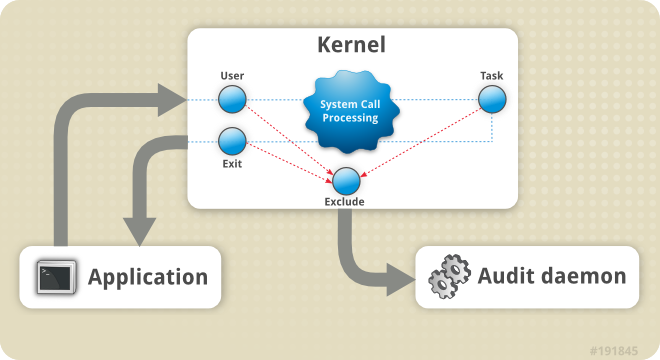이 콘텐츠는 선택한 언어로 제공되지 않습니다.
Chapter 7. System Auditing
The Linux Audit system provides a way to track security-relevant information on your system. Based on pre-configured rules, Audit generates log entries to record as much information about the events that are happening on your system as possible. This information is crucial for mission-critical environments to determine the violator of the security policy and the actions they performed. Audit does not provide additional security to your system; rather, it can be used to discover violations of security policies used on your system. These violations can further be prevented by additional security measures such as SELinux.
The following list summarizes some of the information that Audit is capable of recording in its log files:
- Date and time, type, and outcome of an event.
- Sensitivity labels of subjects and objects.
- Association of an event with the identity of the user who triggered the event.
- All modifications to Audit configuration and attempts to access Audit log files.
- All uses of authentication mechanisms, such as SSH, Kerberos, and others.
- Changes to any trusted database, such as
/etc/passwd. - Attempts to import or export information into or from the system.
- Include or exclude events based on user identity, subject and object labels, and other attributes.
The use of the Audit system is also a requirement for a number of security-related certifications. Audit is designed to meet or exceed the requirements of the following certifications or compliance guides:
- Controlled Access Protection Profile (CAPP)
- Labeled Security Protection Profile (LSPP)
- Rule Set Base Access Control (RSBAC)
- National Industrial Security Program Operating Manual (NISPOM)
- Federal Information Security Management Act (FISMA)
- Payment Card Industry — Data Security Standard (PCI-DSS)
- Security Technical Implementation Guides (STIG)
Audit has also been:
- Evaluated by National Information Assurance Partnership (NIAP) and Best Security Industries (BSI).
- Certified to LSPP/CAPP/RSBAC/EAL4+ on Red Hat Enterprise Linux 5.
- Certified to Operating System Protection Profile / Evaluation Assurance Level 4+ (OSPP/EAL4+) on Red Hat Enterprise Linux 6.
Use Cases
- Watching file access
- Audit can track whether a file or a directory has been accessed, modified, executed, or the file's attributes have been changed. This is useful, for example, to detect access to important files and have an Audit trail available in case one of these files is corrupted.
- Monitoring system calls
- Audit can be configured to generate a log entry every time a particular system call is used. This can be used, for example, to track changes to the system time by monitoring the
settimeofday,clock_adjtime, and other time-related system calls. - Recording commands run by a user
- Because Audit can track whether a file has been executed, a number of rules can be defined to record every execution of a particular command. For example, a rule can be defined for every executable in the
/bindirectory. The resulting log entries can then be searched by user ID to generate an audit trail of executed commands per user. - Recording security events
- The
pam_faillockauthentication module is capable of recording failed login attempts. Audit can be set up to record failed login attempts as well, and provides additional information about the user who attempted to log in. - Searching for events
- Audit provides the ausearch utility, which can be used to filter the log entries and provide a complete audit trail based on a number of conditions.
- Running summary reports
- The aureport utility can be used to generate, among other things, daily reports of recorded events. A system administrator can then analyze these reports and investigate suspicious activity furthermore.
- Monitoring network access
- The iptables and ebtables utilities can be configured to trigger Audit events, allowing system administrators to monitor network access.
Note
System performance may be affected depending on the amount of information that is collected by Audit.
7.1. Audit System Architecture
링크 복사링크가 클립보드에 복사되었습니다!
The Audit system consists of two main parts: the user-space applications and utilities, and the kernel-side system call processing. The kernel component receives system calls from user-space applications and filters them through one of the three filters: user, task, or exit. Once a system call passes through one of these filters, it is sent through the exclude filter, which, based on the Audit rule configuration, sends it to the Audit daemon for further processing. Figure 7.1, “Audit system architecture” illustrates this process.
Figure 7.1. Audit system architecture
The user-space Audit daemon collects the information from the kernel and creates log file entries in a log file. Other Audit user-space utilities interact with the Audit daemon, the kernel Audit component, or the Audit log files:
- audisp — the Audit dispatcher daemon interacts with the Audit daemon and sends events to other applications for further processing. The purpose of this daemon is to provide a plug-in mechanism so that real-time analytical programs can interact with Audit events.
- auditctl — the Audit control utility interacts with the kernel Audit component to control a number of settings and parameters of the event generation process.
- The remaining Audit utilities take the contents of the Audit log files as input and generate output based on user's requirements. For example, the aureport utility generates a report of all recorded events.
